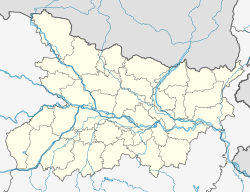| Maa Ratneshwari Mandir | |
|---|---|
माँ रत्नेश्वरी मंदिर | |
 Top View of Maa Ratneshwari Temple | |
| Religion | |
| Affiliation | Hinduism |
| District | Darbhanga |
| Deity | Durga (Maa Ratneshwari Devi) |
| Festivals | Navaratri, Durga Puja |
| Governing body | Maa Ratneshwari Pooja Samiti |
| Location | |
| Location | Ratanpur Abhiman |
| State | Bihar |
| Country | |
| Geographic coordinates | 26°17′32″N85°44′29″E / 26.292112°N 85.7414439°E |
| Architecture | |
| Type | Traditional Hindu Temple |
| Completed | Unknown |
| Specifications | |
| Direction of façade | East |
| Temple(s) | 1 |
| Elevation | 52 m (171 ft)Approximate elevation |
| Website | |
| "www.jaymaaratneshwari.com". | |
| Shakta pitha Maa Durga Vaishnavi | |
Maa Ratneshwari Temple, also known as Maa Ratneshwari Mandir or locally called Durga Asthan, is a Hindu temple located in the eastern part of Ratanpur Abhiman, in Darbhanga, Bihar. The temple is dedicated to Maa Durga in her Lakshmi Swarupa form and has been a site of religious significance for centuries.

